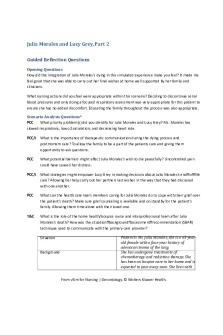Julia Morales Lucy Grey 2reflection PDF

| Title | Julia Morales Lucy Grey 2reflection |
|---|---|
| Author | ms ms |
| Course | Practical Nursing V |
| Institution | Herzing University |
| Pages | 2 |
| File Size | 93.3 KB |
| File Type | |
| Total Downloads | 100 |
| Total Views | 166 |
Summary
Guided reflection questions needed to be submitted with corresponding VSIM....
Description
Julia Morales and Lucy Grey, Part 2 Guided Reflection Questions Opening Questions How did the integration of Julia Morales’s dying in this simulated experience make you feel? It made me feel good that she was able to carry out her final wishes at home well supported by her family and clinicians. What nursing actions did you feel were appropriate within this scenario? Deciding to discontinue serial blood pressures and only doing a focused respiratory assessment was very appropriate for this patient to ensure she has no added discomfort. Educating the family throughout the process was also appropriate. Scenario Analysis Questions* PCC What priority problem(s) did you identify for Julia Morales and Lucy Grey? Ms. Morales has slowed respirations, low o2 saturation, and decreasing heart rate. PCC/I What is the importance of therapeutic communication during the dying process and postmortem care? To allow the family to be a part of the patients care and giving them opportunity to ask questions. PCC
What potential barriers might affect Julia Morales’s wish to die peacefully? Uncontrolled pain could have caused her distress.
PCC/I What strategies might empower Lucy Grey in making decisions about Julia Morales’s end-of-life care? Allowing her help carry out her partners last wishes in the way that they had discussed with one another. PCC
What can the health care team members caring for Julia Morales do to cope with their grief over the patient’s death? Make sure grief counseling is available and on standby for the patient’s family. Allowing them time alone with their loved one.
T&C
What is the role of the home health/hospice nurse and interprofessional team after Julia Morales’s death? How was the situation-background-assessment-recommendation (SBAR) technique used to communicate with the primary care provider? Situation
Background
Patient is Ms. Julia Morales; she is a 65-yearold female with a four-year history of adenocarcinoma of the lung. She has undergone treatments of chemotherapy and radiation therapy. She has been on hospice care in her home and is expected to pass away soon. She lives with From vSim for Nursing | Gerontology. © Wolters Kluwer Health.
Assessment
Recommendation
her longtime partner and caregiver; her adult son is also present during today’s visit. A focused respiratory assessment reveals she is only breathing at a few breathes per minute, O2 sats at 80% on room air, and her lung sounds are diminished with crackles bilaterally to auscultation. She is unresponsive and appears to be comfortable now. During the visit her respirations and heart rate ceased, and she passed away. Postmortem procedures are discussed with the family and the funeral home has been contacted. It is recommended that hospice continue to be available to the family for grieving support services as needed.
S
What measures can ensure Lucy Grey’s safety after Julia Morales’s death? Continued home visits.
QI
What measures can support Lucy Grey following Julia Morales’s death? Continued home/phone visits, grief counseling, assistance with arrangements.
Concluding Questions Reflecting on Julia Morales and Lucy Grey’s case, were there any actions you would do differently? If so, what were these actions, and why would you do them differently? I would not have done anything differently. How would you apply the knowledge and skills that you obtained in Julia Morales and Lucy Grey’s case to an actual patient care situation? Remaining calm and continually informing the family of each aspect is important skills that I would use if placed in a similar situation.
*The Scenario Analysis Questions are correlated to the Quality and Safety Education for Nurses (QSEN) competencies: Patient-Centered Care (PCC), Teamwork and Collaboration (T&C), Evidence-Based Practice (EBP), Quality Improvement (QI), Safety (S), and Informatics (I). Find more information at: http://qsen.org/
From vSim for Nursing | Gerontology. © Wolters Kluwer Health....
Similar Free PDFs

Informative 2Reflection
- 1 Pages

LUCY Lurie
- 6 Pages

Lucy - HISTORIA
- 4 Pages

Personas Morales
- 5 Pages

Indivisibilidad - Morales
- 4 Pages

Blue grey resume
- 1 Pages

Lucy - Grade: B
- 6 Pages

Abdomen - Resumen Anatomia de grey
- 84 Pages

Lean Thinking Julia Bozon
- 2 Pages

Reseña Cincuenta sombras de grey
- 2 Pages

Abdomen - Resumen Anatomia de grey
- 59 Pages

Lucy Paper - Grade: A+++++
- 10 Pages

Lucy v. Zehmer - notes
- 5 Pages
Popular Institutions
- Tinajero National High School - Annex
- Politeknik Caltex Riau
- Yokohama City University
- SGT University
- University of Al-Qadisiyah
- Divine Word College of Vigan
- Techniek College Rotterdam
- Universidade de Santiago
- Universiti Teknologi MARA Cawangan Johor Kampus Pasir Gudang
- Poltekkes Kemenkes Yogyakarta
- Baguio City National High School
- Colegio san marcos
- preparatoria uno
- Centro de Bachillerato Tecnológico Industrial y de Servicios No. 107
- Dalian Maritime University
- Quang Trung Secondary School
- Colegio Tecnológico en Informática
- Corporación Regional de Educación Superior
- Grupo CEDVA
- Dar Al Uloom University
- Centro de Estudios Preuniversitarios de la Universidad Nacional de Ingeniería
- 上智大学
- Aakash International School, Nuna Majara
- San Felipe Neri Catholic School
- Kang Chiao International School - New Taipei City
- Misamis Occidental National High School
- Institución Educativa Escuela Normal Juan Ladrilleros
- Kolehiyo ng Pantukan
- Batanes State College
- Instituto Continental
- Sekolah Menengah Kejuruan Kesehatan Kaltara (Tarakan)
- Colegio de La Inmaculada Concepcion - Cebu


